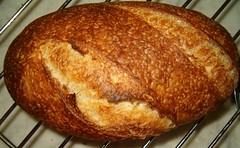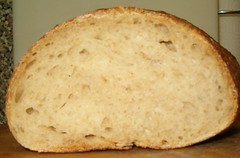Ten days ago I began my journey in the land of sourdough.
My very first sourdough starter was made following the excellent instructions in tattooedtonka and jmonkeys epic starter catching tandem trial. Nursed with rye and weaned to bread flour on day 4, the starter looked ready to leave the nursery and go to work at the end of 8 days. Day 9 became my first ever sourdough bread baking attempt.
I used Jeffrey Hamelman's recipe for Vermont Sourdough with Whole Wheat which has 20% "mature" levain at 125% hydration. I scaled the final dough weight down to 36 oz (for 2 loaves) but I did the math beforehand so I'm confident I didn't introduce any changes into the ingredient proportions.
The bread looked OK when done (perhaps a little dense, but then, so am I)...


I've never eaten sourdough bread before, but this bread was far too sour for my taste.
Is bread made with wild yeast always sour? If not, I can offer only one clue to what went wrong - my times did not at all conform with Hamelman's suggested times for these steps...
- Suggested time for the levain build is 12 to 16 hours (at 70°F). Mine took 5 (at about 76°F).
- Suggested time for the bulk fermentation is 2 to 2½ hours (at 76°F). Mine took 6 (also at 76°F).
Was my starter too young when it left the nursery to take it's place in the workaday world? Did I, the doting parent, force it to become a child laborer? If yes, my only excuse is total ignorance of starter behavior during childhood and adolescence. During the levain build my starter was extremely active. It may not have been mature but, as far as I could see, it sure was acting mature.
I have the medical records from the pediatrician for this growth period. Here they are...
| Weight | Time | Feeding Amount | Observations & Comments |
|---|---|---|---|
| 60 gm | 6:30 AM | 46 gm bread flour, 58 gm water | doubled in bulk in 2-1/2 hrs stirred down for next feeding |
| 164 gm | 9:00 AM | 47 gm bread flour, 58 gm water | tripled in bulk in 2-1/2 hrs |
| 269 gm | 11:30 AM | none | 207 gm removed for bread 1 hour recreation time then stirred down and refrigerated |
I know starter has both yeast and lactobacillus. Does my starter have a personality imbalance? If yes, what practical steps can I take to foster a more harmonious state?
Hi subfuscpersona,
Sourdough bread is almost always a little sour (that's what we want, right?) But it doesn't have to, and shouldn't, taste like vinegar.
A couple of questions for you:
How had you been feeding your starter prior to building the final levain build? (I.e., feeding schedule, ratio of starter:flour:water). What kind of expansion were you getting after feeding on this schedule? And how did it taste and smell?
I have to say, as much as I love Hamelman's book, I think his instructions for elaborating the culture are unnecessarily complicated. I will elaborate on this in the context of your question if you tell me the feeding schedule your baby had been accustomed to before you made it go out and get a job.
Susanfnp
http://www.wildyeastblog.com
hi Susan. Thanks so much for responding. I couldn't ask for a better consultant. Now, on to your questions...
To create my starter I used information from TFL, especially the excellent instructions in tattooedtonka and jmonkeys epic starter catching tandem trial. This thread was simple to understand, very funny and had lots of pictures. Much better than Hamelman's instructions in every way.
Now for the specifics of my starter's infancy...
Materials
Ingredients
Days 1 through 3 - Microscopic Life Begins
30 gm water
3 drops organic cider vinegar
add rye flour, mix well, cover jar
no perceptible rise
30 gm water
opps! forgot the cider vinegar
mix well, cover jar
no perceptible rise
noticeable alcohol fumes
30 gm water
3 drops organic cider vinegar
add flour and vinegar water to rye sludge,
mix well, cover jar
Days 4 through 8 - Observable Life Begins
From Day 4 onward, the infant starter was fed twice a day with bread flour and water. Vinegar, having (hopefully) prevented any growth of leukonostoc bacteria, was abandoned. The amount of water was increased slightly to make the mixture more like thick batter and less like sludge.
(Wow! I could give up sniffing glue and just stick with infant starter.)
30 gm bread flour
about 40 gm water
add flour and water
mix well, cover jar
30 gm bread flour
about 40 gm water
mix well, cover jar
Why yes, Virginia, I believe it has!
30 gm bread flour
about 40 gm water
add flour and water
mix well, cover jar
Has doubled in bulk
Noticeable decline in alcohol smell
(Oh well, back to the glue)
30 gm bread flour
about 40 gm water
mix well, cover jar
(Can tell from starter residue on jar)
Eye witness testimony, "I was there the whole time and saw it happen. It was awesome."
8:00 AM and 8:00 PM feedings
noticeable bubbles throughout
continues to triple in bulk within 3 hrs of feeding
At the end of 8 days starter tasted mild with a some tang. Gluten threads were clearly visible throughout. Time to build the levain!
PS - re my remarks on sour taste
Your response "Sourdough bread is almost always a little sour (that's what we want, right?)" made me realize I'd thought of sourdough as non-descriptive, sorta like Wonder Bread. I don't expect Wonder Bread to taste wonderful and I foolishly didn't expect sourdough to taste sour.
Oddly enough, the simple passage of time seems to alter the taste of the bread. The first slice, eaten after the loaves had cooled overnight, had a distinct tang (ummm, it was sour). A slice at dinner was milder, with less sour aftertaste.
FWIW, I too, about a few months ago, made my first sourdough bread from a starter that was about 2 weeks old. A couple of mistakes I made in the making of the starter, was that I was only giving it a 2:1:1 feeding (50g starter, 25g flour, 25g water). I now use a 4:1:1 (25g, 100g, 100g). Also, I wasn't stiring it well enough. I too, used wooden chopsticks, but then I used a fork and really worked it in (actually, I placed a fork in the end of a cordless drill and used it as a mixer). These two changes made my starter really come to life in no time.
My first bread was very tangy. So tangy, that I went to the local grocery store and got a sourdough loaf labeled "Very sour sourdough bread". Sure enough, same taste (if I had to guess, my loaf was even a little more sour). perhaps you should go and get yourself a grocery loaf to compare...
Since then, I haven't attempted another, however, I keep feeding my starter ever weekend (keep it in the fridge), and will one day revisit the sourdough bread thing. In fact, the starter is probably a couple months old right now. Perhaps that will make the difference.
I think one reason why your bread was so sour was that the starter was probably too sour to begin with. Also that 6 hours was too long to ferment that dough. Both of these things would make your bread more sour.
Looking at your feeding regimen, even without reading your notes on its behavior, my thought is that you were not feeding it enough. And then when I see that it triples quickly but falls down, that thought is confirmed. You're looking for the starter to about double-to-triple itself in approx. 8 hours and hold more or less there until the next feeding. If it reaches its peak too early and then is sitting around waiting for the next meal, it will continue to get more and more sour.
My suggestion is to continue to feed the starter every 12 hours, but with a much lower inoculum of existing starter to new flour. You may need to experiment some. I maintain a 100% hydration starter and generally feed about 1:4:4 (starter:flour:water by weight). This ratio was higher in the summer when temps in my kitchen were higher.
Now when you want to use the starter, just feed on your normal schedule and use it when it's peaked. To get as much as you need for the bread you may have to start with a little more starter at the final feeding (i.e., not discard as much) but you don't need to go through the two-step "levain build" like Hamelman describes, unless you need WAY more starter than you're starting with. In his example he goes from one to 15 pounds, which makes sense to do in 2 steps. But if we home bakers maintain about 75 - 100 grams of starter, we should have enough to elaborate into more than what we need in just one feeding if the feed is 1:2:2 or greater.
I think I rambled. I hope this makes sense. Keep at it, you are a good baker and you can make good sourdough!
Susanfnp
http://www.wildyeastblog.com
Again, FWIW, I was in the same boat as you about a month ago. My bread was WAY too sour for my taste. But, I think I figured it out. I baked another loaf this weekend and results were great!!! Here's what I learned; I think my starter was too young. It's now a little over 1 month old (not counting the initial creation phase). And when I went to use the starter, I harvested it right before the end of it's peak (actually, probably more like halfway). I didn't use ANY commercial yeast. This made it take allot longer to rise, but I'm a pureist like that.
If your results are still bad... Do what I did, and just keep it around for another month. Take it from the fridge every weekend and feed it... and when the day comes, get your starter while it's on the 'rise'. My prediction is that it's starts getting sour after the peak.
Also, to instill what you probably already learned, use a 1:4:4 feeding. Also, mix the heck out of it when you do. One thing I do, is I give it water first, mix it in, then the flour, to make sure the yeasts are very well mixed in throughout the new feeding.
-m
My SD bread is a little too sour for me as well, especially after the 2nd day.
Thanks for the suggestions above. Now I know I should have fed the starter with more flour and water. I don't weight but I guess my ratio for SD starter; FLOUR: WATER was about 1:0.8:0.8 and I left it there for 12 hours before using it.
I have 2 questions though
1.about levain though , the pre fermentation. Can we still keep doing pre fermentation if we want to make bread less sour? i thought that is a critical part to make a SD bread to have rich flour flavor. I did it every time when I made bread so far.
2. I heard that one big reason for using SD yeast instead of instant yeast is because of the slow fermentation of SD yeast brings more flour flavor and good texture for the bread. If we try to make it quick ( to make it less sour ) , then does it still have much diff from instant yeast? (i know there are still diff but doesn't feel much diff anymore)
Just realized this post started from 2007.Amazing. I guess everyone above has learnt A LOT more during past 9 YEARS!!!